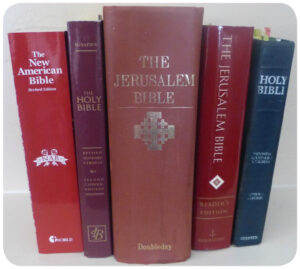Bible translations
 At Turning to God’s Word we rely on several different translations of the Bible, depending on how the Scripture is to be used. Below we’ve included a brief explanation of each translation we use, plus links to online versions.
At Turning to God’s Word we rely on several different translations of the Bible, depending on how the Scripture is to be used. Below we’ve included a brief explanation of each translation we use, plus links to online versions.
Revised Standard Version Catholic Editions—In our printed Catholic Bible studies we use the Revised Standard Version—Second Catholic Edition (RSV2CE) translation of the Bible. We like it for in-depth Scripture study since it’s considered more of a word-for-word translation than many others. Pope Benedict XVI quotes from the RSV2CE in his book, Jesus of Nazareth. The Revised Standard Version Catholic Edition (RSVCE) translation is used in the Catechism of the Catholic Church. The RSVCE and NABRE are the translations linked on all of our online study pages.
The New American Bible Revised Edition—The New American Bible (NAB) is another well-regarded Catholic translation. A slight variation of the NABRE is proclaimed at Mass, so that’s the version we link to on the United States’ Conference of Catholic Bishops’ (USCCB’s) website for the daily Scripture reflection at the top of our home page. The NABRE was released in 2011, updating the New American Bible (NAB), which was released in 1970.
The Abbey Psalms and Canticles—Our online lesson study pages for Sing a New Psalm: Communicating with God Through the Prayers of the Church include a link to an online version of The Revised Grail Psalms, the 2010 translation prepared by the monks at Conception Abbey. The Abbey Psalms and Canticles, published in 2020 by the United States Conference of Catholic Bishops (USCCB) contains minor revisions.
There’s truth to the Latin adage, “Every translator is a traitor.” The oldest biblical manuscripts are written in Greek, Hebrew, and Aramaic, and unless you are adept at reading and understanding those languages, there are bound to be times when the original meaning is lost.
Bible translations vary considerably in terms of accurate rendering of the ancient manuscripts upon which the biblical text is based. Varying manuscripts also can reflect—wittingly or unwittingly—differing ideas about doctrine. A plethora of interpretations by commentators who aren’t competent linguistic scholars adds to the confusion.
For many people, owning one Bible is enough. Those who become more serious about their personal study of Scripture quickly discover the benefits of referring to more than one translation to shed light on the meaning of difficult passages. The next step is learning the original languages in which the Bible was written, but this represents a commitment that few people are able or willing to make. Even a surprisingly large number of theologians and scholars with some background in ancient Greek and Hebrew rarely take the time to read Scripture in those languages.
The Bible was not originally written in English, which means that when most of us read Scripture, we’re reading a translation. There are a number of Catholic translations available, but finding the right Bible can pose a bit of challenge. The following pages may help:
comparing translations—beginning with the Greek New Testament from the 1st century and ending with contemporary English translations
interlinear Bibles—advantages and pitfalls of word-for-word translations
The Abbey Psalms and Canticles—a new translation approved for liturgy in the United States
 learn more about words in the Bible
learn more about words in the Bible
Lost in Translation is a weekly e-column about biblical translation written by  Turning to God’s Word author Matthew Phelps. You can visit the searchable online archives on our Lost in Translation page to read Matthew’s past entries about the original meaning of words used in Scripture. New e-columns are posted every Monday. If you’d like to receive a copy of Matthew’s most recent Lost in Translation by email each week, use this link to let us know.
Turning to God’s Word author Matthew Phelps. You can visit the searchable online archives on our Lost in Translation page to read Matthew’s past entries about the original meaning of words used in Scripture. New e-columns are posted every Monday. If you’d like to receive a copy of Matthew’s most recent Lost in Translation by email each week, use this link to let us know.
